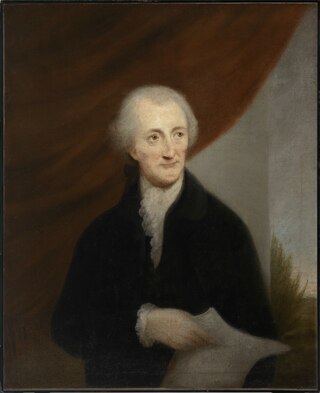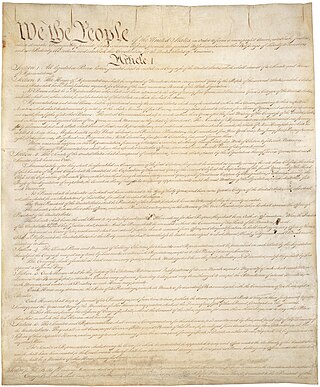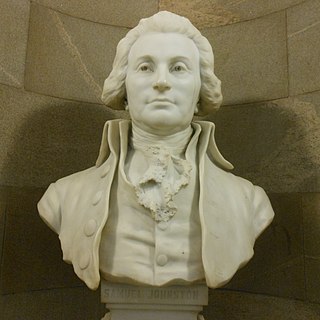| |||||
| Decades: | |||||
|---|---|---|---|---|---|
| See also: | |||||
| 1787 in the United States |
| 1787 in U.S. states |
|---|
| States |
| List of years in the United States |
Events from the year 1787 in the United States. The United States Constitution was written and the ratification process began.
| |||||
| Decades: | |||||
|---|---|---|---|---|---|
| See also: | |||||
| 1787 in the United States |
| 1787 in U.S. states |
|---|
| States |
| List of years in the United States |
Events from the year 1787 in the United States. The United States Constitution was written and the ratification process began.

The Articles of Confederation and Perpetual Union was an agreement among the 13 states of the United States, formerly the Thirteen Colonies, that served as the nation's first frame of government. It was debated by the Second Continental Congress at Independence Hall in Philadelphia between July 1776 and November 1777, and finalized by the Congress on November 15, 1777. It came into force on March 1, 1781, after being ratified by all 13 colonial states. A guiding principle of the Articles was the establishment and preservation of the independence and sovereignty of the states. The Articles consciously established a weak central government, affording it only those powers the former colonies had recognized as belonging to king and parliament. The document provided clearly written rules for how the states' league of friendship, known as the Perpetual Union, would be organized.

Thomas McKean was an American lawyer, politician, and Founding Father. During the American Revolution, he was a Delaware delegate to the Continental Congress in Philadelphia, where he signed the Continental Association, the Declaration of Independence, and the Articles of Confederation. McKean served as a President of Congress.

1787 (MDCCLXXXVII) was a common year starting on Monday of the Gregorian calendar and a common year starting on Friday of the Julian calendar, the 1787th year of the Common Era (CE) and Anno Domini (AD) designations, the 787th year of the 2nd millennium, the 87th year of the 18th century, and the 8th year of the 1780s decade. As of the start of 1787, the Gregorian calendar was 11 days ahead of the Julian calendar, which remained in localized use until 1923.

The 1804 United States presidential election was the fifth quadrennial presidential election, held from Friday, November 2, to Wednesday, December 5, 1804. Incumbent Democratic-Republican president Thomas Jefferson defeated Federalist Charles Cotesworth Pinckney of South Carolina. It was the first presidential election conducted following the ratification of the Twelfth Amendment to the United States Constitution, which reformed procedures for electing presidents and vice presidents.

George Read was an American politician from New Castle in New Castle County, Delaware. He was a Continental Congressman from Delaware, a delegate to the U.S. Constitutional Convention of 1787, president of Delaware, and a member of the Federalist Party. In addition, Read served as U.S. Senator from Delaware and chief justice of Delaware.

Charles Cotesworth Pinckney was an American statesman, military officer and Founding Father who served as United States Minister to France from 1796 to 1797. A delegate to the Constitutional Convention where he signed the Constitution of the United States, Pinckney was twice nominated by the Federalist Party as its presidential candidate in 1804 and 1808, losing both elections.

The United States Constitution has served as the supreme law of the United States since taking effect in 1789. The document was written at the 1787 Philadelphia Convention and was ratified through a series of state conventions held in 1787 and 1788. Since 1789, the Constitution has been amended twenty-seven times; particularly important amendments include the ten amendments of the United States Bill of Rights and the three Reconstruction Amendments.

Richard Dobbs Spaight was an American Founding Father, politician, planter, and signer of the United States Constitution, who served as a Democratic-Republican U.S. Representative for North Carolina's 10th congressional district from 1798 to 1801. Spaight was the eighth governor of North Carolina from 1792 to 1795. He ran for the North Carolina Senate in 1802, and Federalist U.S. Congressman John Stanly campaigned against him as unworthy. Taking offense, Stanly challenged him to a duel on September 5, 1802, in which Stanly shot and mortally wounded Spaight, who died the following day.

Alexander Martin was a Founding Father of the United States, framer of the U.S. Constitution, fourth and seventh Governor of North Carolina, and an infantry officer in the American Revolutionary War. In private life, Martin was a lawyer, merchant, planter, and slave owner.

Richard Bassett was an American politician, attorney, slave owner and later abolitionist, veteran of the American Revolution, signer of the United States Constitution, and one of the Founding Fathers of America. He also served as United States Senator from Delaware, chief justice of the Delaware Court of Common Pleas, governor of Delaware and a United States circuit judge of the United States Circuit Court for the Third Circuit.

Thomas Collins was an American planter and politician from Smyrna, in Kent County, Delaware. He was an officer of the Delaware militia during the American Revolution, and served in the Delaware General Assembly and as President of Delaware.
Thomas Cooper (1764–1829) was a Delaware lawyer and politician who was a Federalist member of the United States House of Representatives. He served in the Thirteenth and Fourteenth Congresses.

The drafting of the Constitution of the United States began on May 25, 1787, when the Constitutional Convention met for the first time with a quorum at the Pennsylvania State House in Philadelphia, Pennsylvania to revise the Articles of Confederation. It ended on September 17, 1787, the day the Frame of Government drafted by the convention's delegates to replace the Articles was adopted and signed. The ratification process for the Constitution began that day, and ended when the final state, Rhode Island, ratified it on May 29, 1790.

The Country Party was a political party in Rhode Island in the Confederation and early Federal periods, from about March 1781 until the death in office of its leader, Governor Arthur Fenner, in October 1805. At its peak of influence, it controlled the Rhode Island General Assembly and dominated state politics from 1785 to 1790. A stridently Anti-Federalist party, it was instrumental in resisting ratification of the Constitution and was the organized vehicle for political expression of popular views that led to Rhode Island both disrupting consensus among states under the Articles of Confederation and being the last of the original 13 states to ratify the Constitution.
Events from the year 1789 in the United States. The Articles of Confederation, the agreement under which the nation's government had been operating since 1781, was superseded by the Constitution in March of this year.
Events from the year 1795 in the United States.
Events from the year 1796 in the United States.
Events from the year 1804 in the United States.

The 1794–95 United States Senate elections were held on various dates in various states. As these U.S. Senate elections were prior to the ratification of the Seventeenth Amendment in 1913, senators were chosen by state legislatures. Senators were elected over a wide range of time throughout 1794 and 1795, and a seat may have been filled months late or remained vacant due to legislative deadlock. In these elections, terms were up for the senators in Class 3.

The Fayetteville Convention was a meeting by 271 delegates from North Carolina to ratify the US Constitution. Governor Samuel Johnston presided over the convention, which met in Fayetteville, North Carolina, from November 16 to 23, 1789 to debate on and decide on the ratification of the Constitution, which had recommended to the states by the Philadelphia Convention during the summer of 1787. The delegates ratified the Constitution by a vote of 194 to 77, thus making North Carolina the 12th state to ratify the constitution.